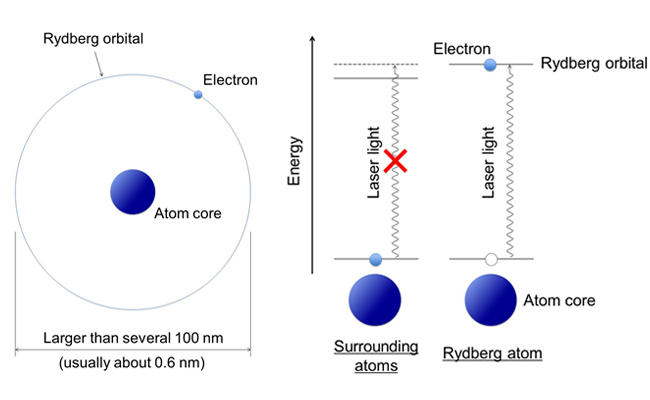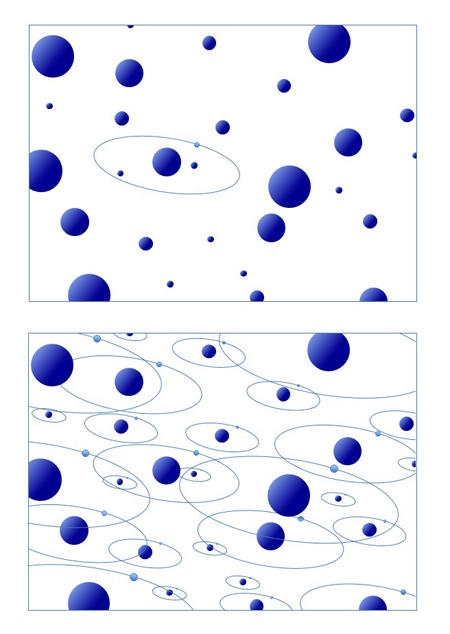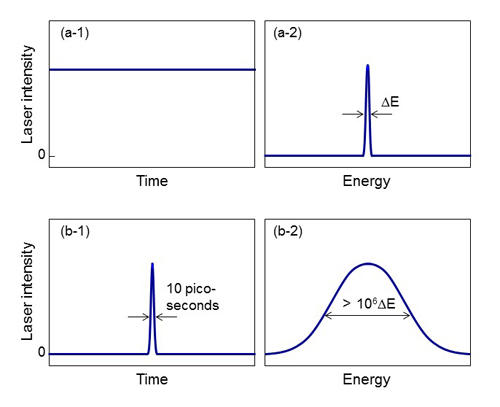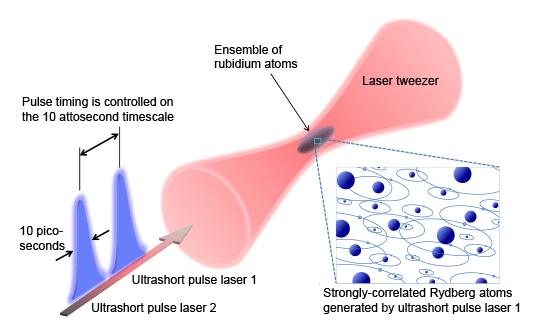Ohmori Group: https://groups.ims.ac.jp/organization/ohmori_g/index-e.html
ABSTRACT
Kenji Ohmori (Institute for Molecular Science, National Institutes of Natural Sciences, Japan) has collaborated with Matthias Weidemüller (University of Heidelberg), Guido Pupillo (University of Strasbourg), Claudiu Genes (University of Innsbruck) and their coworkers to develop the world’s fastest simulator that can simulate quantum mechanical1) dynamics of a large number of particles interacting with each other within one billionths of a second.
The dynamics of many electrons interacting with each other governs a variety of important physical and chemical phenomena such as superconductivity, magnetism, and chemical reactions. An ensemble of many particles thus interacting with each other is referred to as a “strongly correlated system”2). Understanding the properties of strongly correlated systems is thus one of the central goals of modern sciences. It is extremely difficult, however, to predict theoretically the properties of a strongly correlated system even if one uses the post-K supercomputer3), which is one of the world’s fastest supercomputers planned to be completed by the year 2020 in a national project of Japan. For example, the post-K cannot exactly calculate even the energy, which is the most basic property of matter, when the number of particles in the system is more than 30. Instead of calculating with a classical computer such as the post-K, an alternative concept has been proposed and referred to as a “quantum simulator”4), in which quantum mechanical particles such as atoms are assembled into an artificial strongly correlated system, whose properties are known and controllable. It is then used to simulate and understand the properties of another strongly correlated system, whose properties are not known. A quantum simulator could simulate quantum mechanical behavior of many particles that cannot be handled even by the post-K, expected to become a next-generation simulation platform to replace supercomputers. Huge investment to the development of quantum simulators has therefore been started recently in national projects of various countries including US, EU, and China.
The team has developed a completely new quantum simulator that can simulate the dynamics of a strongly correlated system of more than 40 atoms within one billionths of a second. This has been realized by introducing a novel approach in which an ultrashort laser pulse whose pulse-width is only 100 billionths of a second is employed to control a high-density ensemble of atoms cooled down to temperatures close to absolute zero5). Furthermore they have succeeded in simulating the motion of electrons of this strongly correlated system that is modulated by changing the strength of interactions among many atoms in the ensemble.
This “ultrafast quantum simulator” is expected to develop into a fundamental tool that supports designing future functional materials and drug molecules, and to serve as a basic tool to investigate the origin of physical properties of matter including superconductivity and magnetism.
This result will be published in Nature Communications, an online scientific journal of UK, on 16th November 2016.
BACKGROUND
In science and technology policies of various countries in recent years, huge investment is being made to the development of science and technology based on quantum mechanics such as quantum computers6), hereafter referred to as “quantum science and technology”. In 2014, for example, UK launched a national program in which 270 million pounds is invested for five years to quantum science and technology. European Commission is planning a new flagship program in which one billion euro will be invested for ten years to quantum science and technology. In US, National Security Agency and National Institutes of Standards and Technology collaborated to found an institute dedicated to quantum science and technology in 2006, and a large amount of budget has constantly been allocated to this institute. China founded a top innovation center for quantum science and technology in 2014. In 2015, Ministry of Education, Culture, Sports, Science and Technology (MEXT) of Japan launched “Committee for Quantum Science and Technology Policy” to discuss Japan’s policy to promote quantum science and technology. One of the main targets common to these science and technology policies of various countries is a particular kind of quantum computer referred to as a “quantum simulator”, which is dedicated to the simulation of so-called “strongly correlated systems”.
A strongly correlated system is an ensemble of many particles interacting with each other. For example, the behavior of a strongly correlated system of electrons governs physical and chemical phenomena that are useful to our modern society such as superconductivity, magnetism, and chemical reactions. Understanding quantum mechanical behavior of a strongly correlated system is thus one of the central goals of modern sciences. It is extremely difficult, however, to predict theoretically the properties of a strongly correlated system even if one uses the post-K supercomputer, which is expected to be one of the world’s fastest supercomputers planned to be completed by the year 2020 in a national project of Japan. For example, the post-K cannot calculate even the energy, which is the most basic property of matter, when the number of particles in the system is more than 30. Instead of calculating with a classical computer such as the post-K, a revolutionary concept has been proposed by an American physicist Richard Feynman7) in 1980’s and is now referred to as a “quantum simulator”, in which quantum mechanical particles such as atoms are assembled into an artificial strongly correlated system, whose properties are known and controllable. It is then used to simulate and understand the properties of another strongly correlated system, whose properties are not known. A quantum simulator was a desk plan at the beginning of its concept in 1980’s, whereas it becomes within our reach in the present 21st century, in which a variety of sophisticated laser techniques have been dramatically developed to control microscopic particles such as atoms. A quantum simulator could quickly simulate quantum mechanical behavior of a large number of particles that cannot be handled even by the post-K supercomputer. It could therefore contribute to the development of future functional materials and drug molecules. A quantum simulator is accordingly one of the main targets of science and technology policies of various countries mentioned above, and being developed at the forefront of keen international competition. Currently it is already possible to assemble large numbers of quantum mechanical particles such as atoms, and one of the focuses of the present worldwide competition is how to generate a strongly correlated system in which those large numbers of particles interact simultaneously with each other.
In order to realize such simultaneous interactions among many particles, it should be effective to assemble a quantum simulator with particles whose forces could reach as far as possible. A “Rydberg atom”8) is expected as the most promising candidate for that. Figure 1 shows a schematic of a Rydberg atom. An atom usually has a diameter of about 0.6 nanometer, but can be irradiated with laser light to bring an electron that moves near its atom core to a high-energy orbital called a “Rydberg orbital”, whose diameter could be more than hundreds of nanometers. The atom thus generated is referred to as a Rydberg atom. Due to its long distance between the atom core with a positive charge and the Rydberg electron with a negative charge, a Rydberg atom generates an electric field that reaches a long distance. If one could build up an ensemble of Rydberg atoms, it should become a strongly correlated system in which those many Rydberg atoms interact simultaneously with each other. However, the strong electric field induced by a Rydberg atom shifts the energies of the Rydberg orbitals of its surrounding atoms as shown in Fig. 2, so that conventional laser light cannot bring electrons of those surrounding atoms to their Rydberg orbitals. Accordingly there can be only one Rydberg atom as is schematically shown in the upper panel of Fig. 3. This phenomenon is referred to as “Rydberg blockade”9). Rydberg blockade needs to be circumvented to generate a strongly correlated system of Rydberg atoms as shown in the lower panel of Fig. 3.

Figure 1: Schematic of a Rydberg atom Figure 2: Mechanism of Rydberg blockade

Figure 3: Rydberg blockaded (upper panel) and strongly correlated (lower panel) Rydberg atoms.
Moreover there is another problem to be solved to realize such a Rydberg quantum simulator. Even if one could generate a strongly correlated system shown in the lower panel of Fig. 3, the strong interaction among the Rydberg atoms would induce the temporal evolution of their quantum states on the timescale of 100 picoseconds (pico = 10-12), which is faster than the timescale of a quantum simulator that has so far been considered by a factor of more than hundred thousand.
In order to create a Rydberg quantum simulator that can simulate a strongly correlated system, therefore, a totally new concept and technique have been needed to solve those two essential problems: (1) how to circumvent Rydberg blockade? ; (2) how to observe the system on the timescale faster by a factor of hundred thousand than the one considered for a quantum simulator so far?
RESEARCH DETAILS
The team has succeeded in solving those two essential problems for the first time. Figure 4a shows a property of laser light that has so far been used typically for the development of a quantum simulator. It shines continuously as shown in Fig. 4(a-1) and is produced by a so-called “continuous wave laser”. This laser light has an extremely narrow range of wavelength (energy) as shown in Fig. 4(a-2). Therefore it cannot bring an electron to the Rydberg orbital that is shifted energetically in the surrounding atom as shown in Fig. 2. Instead of using this continuous wave laser, therefore, the team has introduced a pulsed laser light that shines only during 10 picoseconds as shown in Fig. 4(b-1). This pulsed laser light has its wavelength range broader than that of the continuous wave laser by a factor of more than one million as shown in Fig. 4(b-2). It can therefore bring an electron to the Rydberg orbital even if its energy is shifted in the surrounding atom. Moreover the temporal width of the laser pulse is one tenth of the timescale expected for the temporal evolution of the system, so that the evolution should be able to be observed in real time.
 Figure 4: Properties of conventional laser light that has so far been used for the development of a quantum simulator (a-1, a-2) and of the one newly introduced by the team (b-1, b-2).
Figure 4: Properties of conventional laser light that has so far been used for the development of a quantum simulator (a-1, a-2) and of the one newly introduced by the team (b-1, b-2).
Moreover the temporal width of the laser pulse is one tenth of the timescale expected for the temporal evolution of the system, so that the evolution should be able to be observed in real time.
The experiment was performed with rubidium atoms10). Figure 5 shows a schematic of the experiment. An ensemble of 106 rubidium atoms was cooled down to an ultralow temperature around one hundred thousandth of an absolute temperature 1 Kelvin with laser cooling11) techniques and trapped in a laser tweezer12). These atoms were irradiated with an “ultrashort laser pulse 1” whose pulse width was 10 picoseconds, and its wavelength range was appropriately manipulated with a special technique. The temporal evolution of the atoms after laser pulse 1 was observed with another “ultrashort laser pulse 2”. The delay of laser pulse 2 from laser pulse 1 was controlled ultra-precisely on the 10 attosecond timescale (atto = 10-18) with a special device, so that the evolution was observed on this timescale. It was then observed in real time that the electrons of many Rydberg atoms, which were generated with laser pulse 1 that circumvented Rydberg blockade, oscillated with a period of one femtosecond (femto = 10-15), and the timing of those oscillations was gradually shifted on the timescale of 10 attoseconds due to the simultaneous interactions among more than 40 Rydberg atoms. Furthermore this timing shift has successfully been accelerated by enlarging the Rydberg orbitals or by decreasing the distances among Rydberg atoms to increase the strength of the interactions.

Figure 5: Schematic of the experimental setup
The team has thus introduced ultrashort laser pulses into a quantum simulator for the first time and succeeded in developing a totally new and the world’s fastest quantum simulator. This ultrafast quantum simulator can simulate the dynamics of a large number of particles interacting with each other that cannot be handled by even a world’s fastest supercomputer such as the post-K. The simulation has been completed in one nanosecond (nano = 10-9).
FUTURE PERSPECTIVE
It has been demonstrated that the ultrafast quantum simulator developed by the team can quickly simulate the dynamics of a strongly correlated system of a large number of particles interacting with each other, which cannot be handled by even the post-K supercomputer. The ultrafast quantum simulator is expected to develop into a future simulation platform that can contribute to designing superconducting and magnetic materials and drug molecules, whose functionalities are governed by strongly correlated electrons. It is also expected to serve as a fundamental tool to investigate the origins of physical properties of matter such as superconductivity and magnetism as well as the mechanism of a chemical reaction that proceeds in a complex environment such as a liquid.
GLOSSARY
1) Quantum mechanical
A microscopic particle such as an electron and an atom has a wave nature that is not observable for a macroscopic particle such as a soccer ball. The branch of physics that deals with such microscopic particles is referred to as “quantum mechanics”. In contrast to particles, waves can be superposed and spatially delocalized. Therefore a microscopic particle such as an electron and an atom can simultaneously be in different states and exist at different points in space. These wave natures that are never seen for macroscopic particles are referred here to as “quantum mechanical”.
2) Strongly correlated system
A “strongly correlated system” is an ensemble of many particles interacting with each other. For example, the behavior of a strongly correlated system of electrons governs a number of important physical and chemical phenomena such as superconductivity, magnetism, and chemical reactions.
3) Post-K supercomputer
The “post-K” supercomputer is a successor to the “K” computer, which is the present flagship supercomputer in Japan, and is currently being developed to be completed by the year 2020 in a national project of Japan. The post-K supercomputer will be able to calculate 100 times faster than the K supercomputer, which executes 10 quadrillion calculations in one second.
4) Quantum simulator
A kind of quantum computer dedicated to the simulation of a strongly correlated system is referred to as a “quantum simulator”, in which quantum mechanical particles such as atoms are assembled into an artificial strongly correlated system that is used to simulate and understand the properties of a strongly correlated system instead of calculating with a classical computer such as the post-K supercomputer.
5) Absolute zero temperature
“Absolute temperature” is a temperature scale in which zero degree is defined as the temperature at which all atoms and molecules stop moving. The unit is Kelvin. Zero Kelvin is called “absolute zero temperature” and is -273.15 degree Celsius, and zero degree Celsius is +273.15 Kelvin.
6) Quantum computer
A “quantum computer” is a computer that applies quantum mechanical properties of matter and/or light to information processing. It consists of an ensemble of quantum mechanical particles such as atoms. Quantum computing is executed by manipulating the states of individual particles and performing logic gates between those particles. A quantum mechanical superposition of different states in a single particle allows for massive parallel computing. The quantum computer is therefore expected to solve some problems much faster than a classical computer.
7) Richard Feynman
Richard Feynman is an American quantum physicist (1918-1988). He was awarded the Nobel Prize in Physics in 1965 together with Sin-Itiro Tomonaga and Julian Schwinger for his contributions to the development of quantum electrodynamics. He is also famous for proposing the concept of a quantum simulator in 1980’s.
8) Rydberg atom
A “Rydberg atom” is an atom whose electron moves in an electron orbital referred to as a “Rydberg orbital” that lies at a large distance from its atom core. The diameter of a Rydberg orbital can range from hundreds of nanometers (nano = 10-9) to micrometers (micro = 10-6). An electron that moves in a Rydberg orbital is referred to as a “Rydberg electron”. Due to its long distance between a Rydberg electron with a negative charge and an atom core with a positive charge, a Rydberg atom has a large dipole moment, so that the interactions among Rydberg atoms are long-range interactions. Due to this long-range interaction, a Rydberg atom is regarded as one of the most promising building blocks to assemble a quantum simulator.
9) Rydberg blockade
A strong electric field induced by a Rydberg atom shifts the energies of the Rydberg orbitals of its surrounding atoms, so that conventional laser light, which shines continuously, cannot bring electrons of those surrounding atoms to their Rydberg orbitals. This phenomenon is referred to as “Rydberg blockade”.
10) Rubidium atom
A “rubidium atom” is an atom with atomic number 37 and one of the alkali metal atoms. It has one electron in the outermost electron orbital near its atom core. By irradiating the atom with laser light, the outermost electron can be easily brought to its Rydberg orbital.
11) Laser cooling
“Laser cooling” is a technique to cool down atoms with laser light to temperatures close to absolute zero. When an atom absorbs laser light, it receives the momentum of the laser light, so that it is pushed toward the propagation direction of the laser light. When an atom moves against the laser light, its speed is gradually reduced, and its energy decreases. An ensemble of atoms can therefore be cooled down to an ultralow temperature around one hundred thousandth of an absolute temperature 1 Kelvin.
12) Laser tweezer
“Laser tweezer” is an experimental tool to trap atoms and small particles by utilizing the spatial intensity-distribution of focused laser light. In the case of atoms, they can be trapped around the focal point of laser light whose wavelength is tuned properly.
Information of the paper
Journal: Nature Communications
Title: Direct observation of ultrafast many-body electron dynamics in an ultracold Rydberg gas
Authors: Nobuyuki Takei, Christian Sommer, Claudiu Genes, Guido Pupillo, Haruka Goto, Kuniaki Koyasu, Hisashi Chiba, Matthias Weidemüller, and Kenji Ohmori
Date: 2016/11/16
DOI: 10.1038/NCOMMS13449
Finantial Supports
Japan Society for the Promotion of Science (JSPS) Grant-in-Aid for Scientific Research (KAKENHI)
Category: Specially Promoted Research
Research Project Number: 16H06289
Title: Addressing Quantum Many-Body Dynamics by Ultrafast Coherent Control with Attosecond Precision
Principal Investigator: Kenji Ohmori, Professor and Chairman, Institute for Molecular Science, National Institutes of Natural Sciences
Research period: April 2016 ~ March 2021
Japan Science and Technology Agency, Strategic Basic Research Programs, CREST
Research Area: Enhancing Applications of Innovative Optical Science and Technologies by making Ultimate Use of Advanced Light Sources
Research Supervisor: Tadashi Ito, Professor, Institute for NanoScience Design, Osaka University
Research Theme: Coherent control in the condensed phase with attosecond precision
Principal Investigator: Kenji Ohmori, Professor and Chairman, Institute for Molecular Science, National Institutes of Natural Sciences
Research period: October 2010 ~ March 2016
Ministry of Education, Culture, Sports, Science and Technology (MEXT) of Japan
Program name: Photon Frontier Network
Research period: FY 2008 ~ 2017
Alexander von Humboldt Foundation and University of Heidelberg
“Humboldt Research Award”
Guest Professor at University of Strasbourg.
Contact
Kenji Ohmori
Professor and Chairman, Department of Photo-Molecular Science, Institute for Molecular Science, National Institutes of Natural Sciences
38 Nishigo-Naka, Myodaiji, Okazaki 444-8585, Japan
Tel: +81-564-55-7361
Fax: +81-564-54-2254
E-mail: ohmori_at_ims.ac.jp (Please replace the "_at_" with @)
URL: https://groups.ims.ac.jp/organization/ohmori_g/index-e.html
Press contact
Public Relations, Institute for Molecular Science, Natural Institutes of Natural Sciences
TEL/FAX: +81-564-55-7262
E-mail: kouhou_at_ims.ac.jp (Please replace the "_at_" with @)
1002



 Figure 4: Properties of conventional laser light that has so far been used for the development of a quantum simulator (a-1, a-2) and of the one newly introduced by the team (b-1, b-2).
Figure 4: Properties of conventional laser light that has so far been used for the development of a quantum simulator (a-1, a-2) and of the one newly introduced by the team (b-1, b-2).